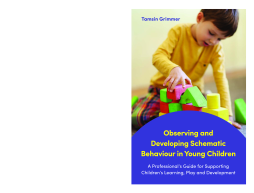
Additional Information
Book Details
Abstract
Observing and understanding schematic behaviour confidently is vital for anyone working with or looking after young children. This guide explains what schemas are, stripping back the technical language often used to describe them, and how to interpret and extend schematic behaviour to benefit the child. It looks specifically at 12 different schemas, such as connection, rotation and transportation, and includes case studies, interpretation of the observations and practical ideas for how to use this information to aid children's learning, development and play.
Making schemas and schematic behaviour more understandable, this book will give early years practitioners and parents the confidence to identify schemas and plan future learning opportunities to support children based on this knowledge.
Tamsin Grimmer is an Early Years Consultant and a one of the Early Years Directors for Linden Learning. She is based in Wiltshire, UK.
Each chapter begins with a stated objective, which makes it easy to identify sections for re-reading or reference if you are dipping into the book to freshen up your knowledge... This book will prove invaluable to any practitioner or setting that is looking to gain a better understanding of schematic bahaviour. This is an accessible text that will prove very popular.
Early Years Educator (EYE) Magazine
Table of Contents
| Section Title | Page | Action | Price |
|---|---|---|---|
| Observing and Developing Schematic Behaviour in Young Children: A Professional’s Guide for Supporting Children’s Learning, Play and Development by Tamsin Grimmer \n | 3 | ||
| Acknowledgements | 9 | ||
| About the Author | 9 | ||
| Introduction | 11 | ||
| 1. Early Brain Development and How We Learn | 21 | ||
| 2. Observing Young Children | 30 | ||
| Schemas | 47 | ||
| 3. Connecting | 49 | ||
| 4. Containing | 58 | ||
| 5. Core and Radial | 68 | ||
| 6. Enclosing | 77 | ||
| 7. Enveloping | 87 | ||
| 8. Going through a Boundary | 98 | ||
| 9. Orientation | 108 | ||
| 10. Positioning | 118 | ||
| 11. Rotation | 128 | ||
| 12. Trajectory | 139 | ||
| 13. Tansforming | 150 | ||
| 14. Transporting | 158 | ||
| 15. Reinterpreting Behaviour | 166 | ||
| 16. In Summary | 178 | ||
| Glossary | 182 | ||
| Index | 186 | ||
| Blank Page |
